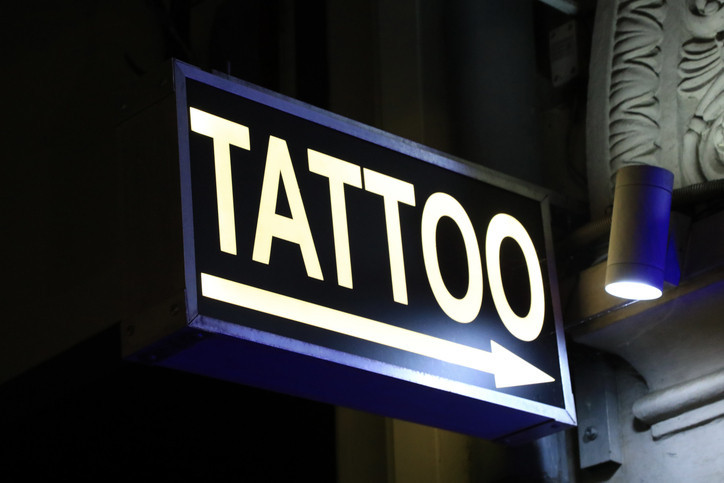Are you worried about the potential link between tattoo ink and cancer? At tattooat.com, we understand your concerns about the safety of tattoos and want to provide you with clear, reliable information. It’s important to separate fact from fiction when it comes to the health risks associated with body art so let’s dive into the truths behind tattoos, ink, and overall health, to help you make informed decisions with a little peace of mind.
1. Why the Concern: The Potential Link Between Tattoos and Cancer
The concern arises from the ingredients found in tattoo ink and the potential impact of these chemicals on the body’s immune system. While tattoos are a popular form of self-expression, there are understandable questions about their safety.
Here’s what sparks the debate:
- Ink Composition: Tattoo inks contain chemicals categorized as carcinogenic (cancer-causing).
- Lymph Node Impact: Tattoo ink pigment can migrate and settle in lymph nodes shortly after getting a tattoo.
- Immune Response: The immune system reacts to tattoo ink chemicals, potentially leading to a body-wide immune response.
- Parallel Triggers: Like lymphoma triggers such as pesticides, tattoo inks can affect immune cells in lymph nodes, raising questions about a connection.
 Close-up of a person's arm with multiple colorful tattoos
Close-up of a person's arm with multiple colorful tattoos
2. Understanding Lymphoma: A Closer Look at the Cancer in Question
Lymphoma is a type of cancer that originates in the lymphatic system, a network of vessels and nodes vital for immune function. Understanding lymphoma is essential when evaluating claims about tattoo ink causing cancer.
Key facts about lymphoma include:
- The lymphatic system which is affected by lymphoma, is a network of vessels and nodes that plays a crucial role in your immune system.
- With about 90,000 new cases diagnosed annually, lymphoma is a common cancer.
- Risk factors include age, infections, chemical exposure, family history, radiation exposure, impaired immune systems, and certain immune diseases.
- Tattoos are not identified as a direct cause or risk factor for lymphoma, prompting investigation into possible links.
3. What Research Says: Exploring the Connection Between Tattoos and Lymphoma
The connection between tattoos and lymphoma remains under investigation. The current body of research is small and doesn’t provide a conclusive link.
Here’s a summary of the available research:
- A 2020 study compared 737 people with non-Hodgkin’s lymphoma to a control group. The study found no significant difference in tattoo frequency between the two groups.
- A May 2024 study that sparked many headlines compared 1,398 lymphoma patients to 4,193 similar individuals without lymphoma.
- Lymphoma was 21% more common in those with tattoos.
- Within two years of getting a tattoo, lymphoma risk was 81% higher.
- Between three and 10 years, no increased risk was found.
- After 11 or more years, lymphoma risk was 19% higher.
- Size and number of tattoos showed no correlation with lymphoma risk.
4. Interpreting the Study Results: Why Caution is Necessary
When interpreting studies linking tattoos and lymphoma, it’s essential to proceed with caution. Several factors undermine the strength of any potential connection.
Important considerations:
- Most rate differences were not statistically significant, meaning the reported link might be due to chance.
- The lack of correlation between tattoo size/number and lymphoma risk weakens the argument for a direct link.
- If tattoos significantly increased lymphoma risk, we would expect to see a corresponding rise in lymphoma rates alongside tattoo popularity. But we are not.
- Association studies can’t prove causation. Other factors common among people with tattoos might account for the higher lymphoma risk.
5. Beyond Lymphoma: Other Potential Health Risks of Tattoos
While the lymphoma link remains unproven, tattoos do carry other health risks. Understanding these risks can help you make informed decisions about getting inked.
According to research, potential health risks include:
| Risk | Description |
|---|---|
| Infection | Bacterial skin infections or viral hepatitis from non-sterile equipment or practices. |
| Allergic Reactions | Reactions to tattoo ink, causing redness, itching, and swelling. |
| Scarring | Formation of keloids or other types of scars at the tattoo site. |
| Skin Cancer | In rare cases, melanoma and other types of skin cancer have been linked to tattoos. |
| Granulomas | These are nodules that may form around tattoo ink. |
| MRI Complications | Rarely, tattoos can cause swelling or burning during an MRI exam, especially tattoos containing iron oxide pigments. |
Alt: A skilled tattoo artist meticulously inks a client’s arm with an intricate design, ensuring precision and artistry in every stroke
6. Reducing Risks: Making Safe Choices When Getting a Tattoo
To minimize the health risks associated with tattoos, make safe and informed choices. These steps can help ensure a positive and healthy experience.
Key precautions include:
- Choosing a Reputable Artist: Select a licensed and experienced tattoo artist with a clean, professional studio.
- Verifying Sterilization Practices: Ensure the artist uses sterile equipment and follows proper hygiene protocols.
- Inquiring About Ink Composition: Ask about the types of ink used, and opt for those with fewer harmful chemicals.
- Following Aftercare Instructions: Adhere to the artist’s aftercare guidelines to prevent infections and promote healing.
- Monitoring for Adverse Reactions: Watch for any signs of infection, allergic reaction, or other complications, and seek medical attention if needed.
7. Tattoo Ink Composition: What’s Really Inked Into Your Skin
Understanding what tattoo ink is made of can help alleviate some concerns about safety. Not all inks are created equal, and knowing the components can inform your choices.
Typical ink ingredients include:
| Component | Purpose | Potential Concerns |
|---|---|---|
| Pigments | Provide color; can be metallic salts or organic dyes | Some pigments may contain heavy metals or carcinogenic dyes |
| Carrier | Liquid that suspends the pigment (e.g., water, alcohol) | Alcohol can cause skin irritation; some carriers have additives |
| Additives | Stabilize the ink, adjust viscosity, or prevent bacterial growth | May include preservatives, pH adjusters, or binding agents |
| Heavy Metals | Some inks may contain trace amounts of heavy metals like lead | These can be toxic in high concentrations |
8. Tattoo Trends and Safety: Staying Informed in a Dynamic Industry
The tattoo industry is constantly evolving, with new trends and safety measures emerging. Staying informed can help you navigate this dynamic landscape.
Recent trends and safety developments include:
- Vegan and Organic Inks: A growing demand for inks made from natural, non-toxic ingredients.
- Improved Sterilization Techniques: Advances in sterilization equipment and protocols to minimize infection risks.
- Government Regulations: Increased scrutiny and regulation of tattoo ink composition and manufacturing processes.
- Educational Resources: More accessible information about tattoo safety through online platforms and industry organizations.
- Collaborations between Artists and Scientists: Some tattoo artists are working with scientists to develop safer and more sustainable inks.
9. Expert Opinions: Perspectives from Tattoo Artists and Medical Professionals
Gaining insights from tattoo artists and medical professionals can provide a well-rounded perspective on tattoo safety. Their expertise can help you make informed decisions.
Expert Opinions:
- According to research from Portland State University’s Art Department, in July 2025, collaborations between artists and scientists are leading to safer ink formulations.
- Inked Magazine emphasizes the importance of choosing reputable artists who prioritize safety and hygiene.
- Dermatologists recommend monitoring tattoos for signs of skin cancer and consulting a doctor if any changes are noticed.
- Many tattoo artists advocate for more transparent labeling of ink ingredients to help consumers make informed choices.
- Medical professionals recommend avoiding tattoos if you have certain skin conditions or a compromised immune system.
10. FAQ: Addressing Your Burning Questions About Tattoo Safety
Here are some frequently asked questions about tattoo safety, providing quick and reliable answers to your most pressing concerns.
Q: Is it true that tattoo ink can cause cancer?
A: While some studies suggest a possible link, there is no conclusive evidence that tattoo ink directly causes cancer.
Q: What are the main health risks associated with getting a tattoo?
A: The main risks include infection, allergic reactions, scarring, and, rarely, skin cancer.
Q: How can I minimize the health risks when getting a tattoo?
A: Choose a reputable artist, ensure sterile practices, inquire about ink composition, and follow aftercare instructions.
Q: What should I do if I experience a reaction to tattoo ink?
A: Seek medical attention immediately if you notice signs of infection, allergic reaction, or other complications.
Q: Are there any types of tattoo ink that are safer than others?
A: Opt for inks with fewer harmful chemicals and consider vegan or organic options.
Q: Can tattoos interfere with medical procedures like MRIs?
A: Rarely, tattoos can cause swelling or burning during an MRI, especially those containing iron oxide pigments.
Q: Is it safe to get a tattoo if I have a skin condition like eczema or psoriasis?
A: It’s best to consult with a dermatologist before getting a tattoo if you have a pre-existing skin condition.
Q: How can I tell if a tattoo studio is reputable and safe?
A: Look for licenses and certifications, cleanliness, sterilization practices, and positive reviews from other clients.
Q: What should I do to care for my tattoo after getting it done?
A: Follow the artist’s aftercare instructions, which typically include keeping the area clean and moisturized.
Q: Where can I find more information about tattoo safety and best practices?
A: Consult with medical professionals, reputable tattoo artists, and trusted online resources like tattooat.com.
Alt: An array of vibrant tattoo designs showcases the diversity and artistry of body art, ranging from traditional motifs to modern, intricate patterns.
11. The Bottom Line: Weighing the Risks and Making Informed Choices
While headlines may raise concerns about the link between tattoos and lymphoma, current evidence is not convincing. However, tattoos do come with other health risks, such as infections and allergic reactions. Reduce these risks by choosing a reputable artist, following aftercare instructions, and staying informed about tattoo safety.
At tattooat.com, we are committed to providing you with the information you need to make informed decisions about tattoos. Our platform offers a wealth of resources, including design inspiration, artist directories, and expert articles. Explore our site to discover the perfect design, find a talented artist, and learn everything you need to know about tattoo safety and aftercare.
Address: 1825 SW Broadway, Portland, OR 97201, United States.
Phone: +1 (503) 725-3000.
Website: tattooat.com.
Ready to explore the world of tattoos with confidence? Visit tattooat.com today!
